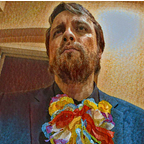In the ancient Greek kingship of Erechtheus, when Athenians sacrificed vegetables rather than animals to their gods, a vegetable sacrifice was being made to Zeus Polieu — “Of the City” — on the Acropolis.
A labouring ox that had wandered away from the fields passed over Zeus’ altar, ate the cake and grain that had been prepared for the sacrifice and trampled on the bronze altar.
A man named Thaulon in anger then killed the ox with an axe. Thaulon was the first Athenian in the city to kill an ox, and after killing the ox he fled the city, leaving the axe behind. The witnesses to the scene were shocked by the event and moved to prosecute Thaulon for the murder of the ox.
Before they could do so, an oracle came to the Athenians and told them that they should eat the ox in a feast and repeat the sacrifice every year. The crowd then ate the ox in a communal meal. Afterwards, still feeling guilty, they held a trial to charge the absent Thaulon, but could not resolve the crime because of a sense of communal responsibility.
The guilt of this event, this lack of justice that had ruined the sacrifice, were subsequently repeated in a rite performed by the Athenians. This ritual survived up until Roman times, and was thought to have an archaic origin by the Athenians.
Every year in the city, on a day in midsummer, the people staged the unusual ritual called the Bouphonia, or “murder of the ox”. A group of oxen was led to the Acropolis, and in the procession were young girls carrying water to sharpen an axe and sacrificial knife. The oxen circled Zeus’ altar, and the first one to taste the cake on the altar was selected as the victim. He was struck with an axe and killed by the “ox-slayer,” a member of the Thaulonidae family. The ox-slayer then threw down the axe and ran away.
The other participants in the ritual then butchered and skinned the animal with a sacrificial knife and feasted on the meat. This could not be the end of the ritual, however, because a crime had been committed — the ox had been murdered. A formal trial was held in a special court in Athens, and since the ox-slayer himself had fled, the girls who brought the water for sharpening the knife and axe were charged with the murder. In their defense they claimed that those who actually sharpened the axe and knife were more responsible.
The sharpeners in turn charged the man who gave them the axe and knife, and he charged the butcher. But the butcher claimed the knife was the more guilty, and, since the knife could say nothing in its defense, it was found guilty of the murder.
The knife was then banished by being thrown into the sea.
To conclude this bizarre ritual, back on the Acropolis the skin of the ox was stuffed, stood up, and harnessed to a plow, restoring it to its pre-sacrificial condition.
Source
The story about buphonia (or ox-slaying) comes from fragments from neo-platonists theophrastus and porphyry. The text above is a creative reworking of “Zeus Polieus, the Bouphonia, and the Ox” in Jon D. Mikalson’s Ancient Greek Religion, pp. 61–2.
The themes of collective guilt, the sacred, violence & animal and thing life in this story have been used by classics scholars such as Walter Burket in Homo Necans to theorise the so-called ‘sacrificial system’ in ancient Greece. This system has been challenged in recent years, and the story of buphonia is now seen as having no corroborating source beyond porphyry himself, the pythagorean neo-platonist who supported abstinence from animal flesh.
What does it mean?
The story is curious. It is probably best treated as a skeptical story or parable about religion and violence, but it does not make sense without understanding the role of the pantheist elements in the story.
That vegetables can be sacrificed, a man can be charged for killing a laboring cow of value, an axe grinder or a knife can be found guilty, or that the death of a cow can be part of a symbolic restitution, only makes sense if you live in a world in which a chain or cascading series of moral values are given to every thing that lives. The horizon of life — zoological or political — is forever moving, or transmogrifying, in such a self-organising social system.
The waste of meat-eating and violence is displayed here in repetition and the continual substitution of objects for the labouring value of a life is exposed to an arbitrary use that at once mystifies and lays bare the decision to kill for pleasure or hate, without clear or consistent reason.
So what does it mean?
This is a story about the origin of the profane use of animals and labour and its religious and political institutionalization. It is perhaps an irony, or evidence for the continuing role of this institutionalization, that classical scholars have made use of the story to support the centrality of agonistic animal-human relations. That is, even though it shows an ecological awareness of the immanent plane of human-animal-object relations.
